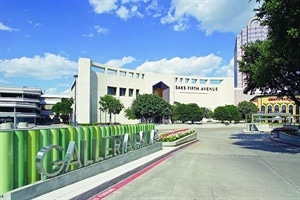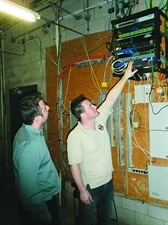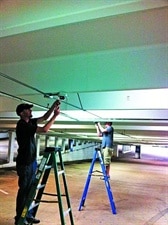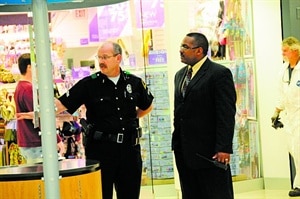They say everything is bigger in Texas, and the sprawling Galleria Dallas shopping center and its new expansive security system live up to that claim. However, what looms largest was the tightly coordinated effort the security consultant, integrator and end user demonstrated to help maximize the facility’s safety.
 There is nothing average about Galleria Dallas. Under a magnificent barrel-vaulted glass skylight, the visitor experience is one of a casual city street replete with shopping, cafes, seating and people watching. To ensure the safest possible environment, Galleria Dallas’ proactive management decided to upgrade the facility’s electronic security including the move to IP-based video surveillance.
There is nothing average about Galleria Dallas. Under a magnificent barrel-vaulted glass skylight, the visitor experience is one of a casual city street replete with shopping, cafes, seating and people watching. To ensure the safest possible environment, Galleria Dallas’ proactive management decided to upgrade the facility’s electronic security including the move to IP-based video surveillance.
The action was initiated without the all-too-typical presence of a precipitating event or upward crime trend forcing the decision. Rather the comfort and security of visitors took center stage, and the upgrade was part of a longstanding trend in strategic thinking on the part of management.
“We want people — guests, employees and visitors — to feel that they have arrived at a safe environment,” explains Angie Freed, general manager of Galleria Dallas. “And knowing that the feeling of security and safety is the No. 1 reason people cite in visiting or not visiting a shopping center, we want to make sure they choose us.”
Galleria Dallas already had CCTV located throughout the shopping center, but management wanted to do more and allocated funds for an upgrade. Egg Harbor Township, N.J.-based consulting firm R. Grossman and Associates Inc. (RG&A) was hired to survey the facility, offer recommendations and assess proposals already in hand.
“We wanted an outside expert to evaluate our systems, make suggestions, and make sure we were moving in the right direction,” explains Earl Morgan, director of security for the property and an Andrews Int’l employee. “We are not experts in this; it’s not what we live and breathe every day,” adds Freed.
The scope of the project would entail helping safeguard the complex’s 1.9 million square feet of retail space and more than 200 retail shops. There is also a four-story glassed-in structure featuring an ice skating rink that is home to the nation’s tallest indoor Christmas tree, 10,000 garaged parking spaces and a 4,300-square-foot, award-winning Children’s Play Place.
Following is a first-hand account of how consultant, integrator and end user forged a rock-solid collaborative union to deliver the best possible security design, installation and final solution. The endeavor would prove the axiom that planning pays off, and include hundreds of cameras, several hundred terabytes of data storage, 90,000 feet of conduit in the parking garage alone, and a total cost in excess of $1 million. (Editor’s note: This project’s nondisclosure agreements bar revealing precise equipment locations and quantities.)
Design Calls for IP Cameras, VMS
It was against this backdrop that RG&A set out to design and specify the system. After two site visits and extensive exploration of the massive property, a scope of work was defined and a specification was created around a “wish list.”
“Anytime you are dealing with a project with a fixed budget, there are a number of ambiguities,” says Robert Sprague, RG&A consultant/project manager assigned to Galleria Dallas. “On the one hand, you want to get your client exactly what they’re looking for. On the other, you need to be mindful of the budget; if your design goes over [budget], you don’t want to go to the expense of rebidding the project. And it’s not fair to put the integrators through that.”
The center initially had a number of analog cameras in public areas. These were recorded on GE/Kalatel DVRs installed in data closets located strategically around the property and linked via a fiber-optic backbone. The DVRs handled storage of the recorded images while a Genetec video management system (VMS) was used to view and play back recorded images from a central command center. There were no cameras in the parking garages and the initial focus of the design was to add complete coverage of the 10,000 parking spaces, and redesign the command center to handle the added workload.
As a standard course of business, RG&A designs projects with a base system and a number of option packages or alternates. The base system is the minimum functionality required, and the options traditionally enhance performance or add features.
In the case of Galleria Dallas, the base system included the parking garage cameras and associated storage and video management. Options included the new command center; added coverage for the interior of the shopping center; increased recorded retention time from the baseline; moving all of the existing cameras off of the DVRs and onto the new system; and replacement of the emergency callbox system. The last option was initially going to be a separate project but the prospect of labor savings compelled management to act sooner.

After replacing the existing DVRs with encoders in the data closets throughout the shopping center, Robert Tabbara (left) and Brian Heldreth of 911 Security review the transition plan to clean up the temporary wiring without causing any system downtime.
In all, 13 bids were received from nine different integrators. In fact, the initial system design had been specified as analog cameras with IP encoders to minimize the cost of replacing vandalized cameras, in case that became a problem in the parking garages. Galleria Dallas stakeholders had mixed feelings about going analog (the “future-proof” nature of a fully IP-based system was appealing) and it was ultimately an alternate proposal that won out.
The project, including all of the specified option packages, was awarded to Dallas-based 911 Security Cameras (911). With 47 employees in four offices (Dallas, Houston, San Antonio and Baton Rouge, La.), 911 was established in 2007. Today the business realizes 80 percent of its revenues from video surveillance and the balance from access control projects.
“We feel this is a great advantage because it really separates us from the competition,” says 911 President Robert Tabbara. “The whole company — techs, sales, support staff — are really knowledgeable about these products. Consequently we are able to evaluate products, get hands-on experience, and become certified on a tremendous depth of products within that market niche. We are certified on seven brands of video management systems and have dealt with almost every kind of camera out there, so we know what to promote and what to avoid.”
The integrator had proposed a fully IP-based system that included high-end products with familiar brand names where appropriate (e.g. Cisco networking, Dell computers, Winsted console), as well as a lesser-known make (ACTi) of fixed cameras.
“I was initially unfamiliar with that brand,” says T. Riley Pierce, senior consultant for RG&A and the person responsible for evaluating substitutions on the project. “911 sent us a sample and we actually had it installed at another site with similar lighting and environmental conditions. But it was the independent feedback from another integrator that pushed me over the edge.”
RG&A leases a warehouse on its property to integrator Pro Video Engineering. When Pierce asked Pro Video’s Tim Longnecker what kind of IP cameras he was using, he responded ACTi without even being prompted. “He had such a large installed base over a long period that we had no problem moving forward with the substitution,” adds Pierce.
Throughout the value engineering phase there were a number of suggestions made by 911 that further refined the system. RG&A’s philosophy is that there is no room for egos on a project. The consultant believes the overriding imperative is providing the client with the best system within their design and budgetary constraints. Hence, all good ideas should be discussed and evaluated.
That sentiment was echoed by both Morgan and Denise Witry, operations director at Galleria Dallas. “We feel it was a good three-way marriage, if you will,” says Witry.
Other equipment manufacturers involved in the project included APC, Panasonic, Salient and Talk-A-Phone.
Solving Power, Cabling Challenges
The level of planning, combined experience of the team, and proximity of the site to 911’s Dallas office made this a relatively painless installation.
Brian Heldreth, project manager for 911, is also a licensed electrician and his extensive experience with larger electrical projects proved helpful. “We ran 90,000 feet of metal pipe in three weeks,” he says. “And throughout all of that, we stayed out of the way completely, with no disturbance to customers or operations.”
A major contributor to things proceeding so smoothly was the level of cooperation between Galleria Dallas and 911. “I can’t think of any time we impacted their ability to complete their work. And a lot of this was happening during the [Thanksgiving and Christmas] holidays, and it was all pretty seamless,” says Witry.
One area where the consultant’s specification made things a little more difficult was the insistence on a dedicated power wire rather than using power over Ethernet (PoE) technology. RG&A had concerns about the cable distances involved, voltage drop and cameras that would draw more power in the future.

Ryan Armstrong (left), crew leader and Josh Davis, senior technician, work on camera and conduit installation after Dallas Galleria operating hours. While the initial intent was to minimize disruption to the shopping center, the off-hours work sped up installation dramatically as it presented a safe and obstacle-free environment that would have been difficult to achieve with heavy traffic in these areas
A team of a dozen 911 employees was assigned to the project, with four subcontracted personnel handling the fiber pull and termination. The team worked from 11 p.m. to 7 a.m. during the conduit installation, cable pull and camera-mounting phase to minimize disruptions.
Tabbara spent about 15 percent of his time onsite making sure things went according to plan and that his people were supported properly. “I like to stay close to the customers and make sure that I hear any complaints or things that could be going wrong. Getting real feedback to make sure we are on schedule is critical, and I also want to be close to my guys. If there are any problems, I can solve them pretty quickly.”
Although the installation phase came off without any especially challenging hurdles or nagging problems, Sprague highlights a few small issues that cropped up.
“Sure, there were the usual changes and improvements,” he says. “There were plans initially to put the IDF points in air-conditioned cabinets in the garage because of the Texas heat, but we felt that would be a failure point once we got past the three-year warranty period. We decided to go with hardened switches and fiber-optic modules that could withstand these environmental conditions and 911 selected ComNet, a relatively new entrant in this field. We looked at them closely and were impressed with the product and the people behind it and it has worked out well.”
Similar problems – though relatively minor – concerning command center layout, rack locations, camera positioning and other issues were worked out quickly and efficiently. A communication practice RG&A has deployed on projects for quite a while worked out particularly well.
“We create an E-mail address for every project,” says RG&A Office Manager Terri Timmons, who handles project communications. “Any messages sent to that address automatically forward to a list of project contacts, including the client and our own people. Once the project is awarded, the integrator adds their people to the list, and if there’s an architect or general contractor we add them as well. It really simplifies things, as no one gets left out. You just send an E-mail to one address and it goes to all the right people.”

Director of Security Earl Morgan walks the shopping center, shown here talking to Dallas Police Sr. Corporal Jeff Ell. 'It is important to visualize the coverage area in person while looking at the cameras,' says Morgan. 'The best way to do that is to review the areas in person, on a regular basis.'
So how is the system working? Galleria Dallas personnel weren’t surprised with the coverage. “We had walked every square inch of the parking garage, so coverage was exactly what we expected,” says Morgan. Asking him about the possibility of adding cameras elicits a smile. “Right now coverage is so good it is hard to imagine where we could possibly need more cameras. I’m sure that once we’ve been working with it for a while we will make some minor tune-ups and adjustments.”
But the real surprise he says was the ease of use: “The other day I had two other security officers with me and I wanted to see how easy it was to go back and review some footage. I asked the operator to show me a review, and she made a couple of mouse clicks — 1 second, 5 seconds, 20 seconds, 30 seconds — she went right where she needed to go and hit ‘play.’ Video popped right up and that’s with no training.”
Other advantages are being realized as well. From an operational standpoint, as the management team continues to get familiarized with the new capabilities, they are looking forward to being able to view cameras from their offices and performing virtual walkthroughs of the facility. Cameras near emergency call boxes will allow security staff to evaluate the situation before dispatching someone and eliminate false alarms. And on the rare occasion when crime does occur they will be able to help law enforcement catch the criminal, which is a powerful deterrent in itself.
Witry sums it up nicely: “You know, from an operations standpoint I have 19 million people who travel in and out of this shopping center on an annual basis. If our security programs — CCTV, call boxes, patrols, bikes, vehicles — provide them with a feeling or perception of safety, and they can go home and say, ‘My visit to Galleria Dallas was just phenomenal from beginning to end,’ it’s something to be proud of.”
Read the original article on the Security Sales & Integration website



